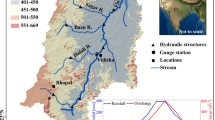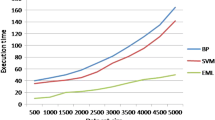Abstract
The wind power forecasting plays a vital role in renewable energy production. Due to the dynamic and uncertain behavior of wind, it is really hard to catch the actual features of wind for accurate forecasting measures. The patchy and instability of wind leading to the assortment of training samples have a main influence on the forecasting accuracy. For this purpose, an accurate forecasting method is needed. This paper proposed a new hybrid approach of clustering based probabilistic decision tree to forecast wind power efficiently. The collected data is screened for noisy information and selected those variables which mainly contribute in accurate predictions. Then, the wind data is normalized using mean and standard deviation to extract playing level fields for each feature. Based on the similarity of the data behavior, the K-means clustering algorithm is applied to classify the samples into different groups which contain the historical wind data. Further, the Naïve Bayes (NB) tree is proposed to extract probabilities for each feature in the clusters. The NB tree is a hybrid model of C4.5 and NB methods that successfully applied on three big real-world wind datasets (hourly, monthly, yearly) collected from National Renewable Energy Laboratory (NREL). The forecasting accuracy exposed that the proposed method could forecast an accurate wind power from hours to years' data. Comprehensive comparisons are made of the proposed method with the most popular state of the art techniques which show that this method provides more accurate prediction results.








Similar content being viewed by others
References
Wan C, Lin J, Wang J, Song Y, Dong ZY (2016) Direct quantile regression for nonparametric probabilistic forecasting of wind power generation. IEEE Trans Power Syst 32(4):2767–2778
Zhao Y, Ye L, Li Z, Song X, Lang Y, Su J (2016) A novel bidirectional mechanism based on time series model for wind power forecasting. Appl Energy 177:793–803
Quan H, Khosravi A, Yang D, Srinivasan D (2019) A survey of computational intelligence techniques for wind power uncertainty quantification in smart grids. IEEE Trans Neural Netw Learn Syst
Kehler J, Hu M, McMullen M, Blatchford J (2010) ISO perspective and experience with integrating wind power forecasts into operations. IEEE PES General Meeting, pp 1–5
Jiang Y, Chen X, Yu K, Liao Y (2017) Short-term wind power forecasting using hybrid method based on enhanced boosting algorithm. J Mod Power Syst Clean Energy 5(1):126–133
Demirdelen T, Aksu IO, Esenboga B, Aygul K, Ekinci F, Bilgili M (2019) A new method for generating short-term power forecasting based on artificial neural networks and optimization methods for Solar photovoltaic power plants. Solar photovoltaic power plants. Springer, Berlin, pp 165–189
Liu H, Mi X-W, Li Y-F (2018) Wind speed forecasting method based on deep learning strategy using empirical wavelet transform, long short term memory neural network and Elman neural network. Energy Convers Manag 156:498–514
Chen Y et al (2017) Short-term electrical load forecasting using the support vector regression (SVR) model to calculate the demand response baseline for office buildings. Appl Energy 195:659–670
Abedinia O, Amjady N, Ghadimi N (2018) Solar energy forecasting based on hybrid neural network and improved metaheuristic algorithm. Comput Intell 34(1):241–260
Jafarian-Namin S, Goli A, Qolipour M, Mostafaeipour A, Golmohammadi AM (2019) Forecasting the wind power generation using Box–Jenkins and hybrid artificial intelligence. Int J Energy Sect Manag
Chen Q, Folly K (2019) Effect of input features on the performance of the ANN-based wind power forecasting. In: 2019 Southern African Universities Power Engineering Conference/Robotics and Mechatronics/Pattern Recognition Association of South Africa (SAUPEC/RobMech/PRASA). IEEE, pp. 673–678.
Kumar N, Singh A, Rai N, Chauhan N (2019) Investigation on short-term wind power forecasting using ANN and ANN-PSO. Applications of computing, automation and wireless systems in electrical engineering. Springer, Berlin, pp 1103–1116
Chen Q, Folly K (2018) Wind power forecasting. IFAC-Pap OnLine 51(28):414–419
Wu W, Peng M (2017) A data mining approach combining $ k $-means clustering with bagging neural network for short-term wind power forecasting. IEEE Internet Things J 4(4):979–986
Tascikaraoglu A, Uzunoglu M (2014) A review of combined approaches for prediction of short-term wind speed and power. Renew Sustain Energy Rev 34:243–254
Shi J, Ding Z, Lee W-J, Yang Y, Liu Y, Zhang M (2014) Hybrid forecasting model for very-short term wind power forecasting based on grey relational analysis and wind speed distribution features. IEEE Trans Smart Grid 5(1):521–526
Xiao L, Wang J, Dong Y, Wu J (2015) Combined forecasting models for wind energy forecasting: a case study in China. Renew Sustain Energy Rev 44:271–288
Liu H, Tian H-Q, Li Y-F (2015) Four wind speed multi-step forecasting models using extreme learning machines and signal decomposing algorithms. Energy Convers Manag 100:16–22
Guo S, Zhao H, Zhao H (2017) A new hybrid wind power forecaster using the beveridge-nelson decomposition method and a relevance vector machine optimized by the ant lion optimizer. Energies 10(7):922
Liu H, Tian H, Liang X, Li Y (2015) New wind speed forecasting approaches using fast ensemble empirical model decomposition, genetic algorithm, mind evolutionary algorithm and artificial neural networks. Renew Energy 83:1066–1075
Lu H, Chang G (2018) Wind power forecast by using improved radial basis function neural network. In: 2018 IEEE Power & Energy Society General Meeting (PESGM), IEEE, pp 1–5
Chandra DR, Kumari MS, Sydulu M, Ramaiah V (2018) State estimation based neural network in wind speed forecasting: a non iterative approach. J Green Eng 8(3):262–282
Jiao R, Huang X, Ma X, Han L, Tian W (2018) A model combining stacked auto encoder and back propagation algorithm for short-term wind power forecasting. IEEE Access 6:17851–17858
Xiaoyun Q, Xiaoning K, Chao Z, Shuai J, Xiuda M (2016) Short-term prediction of wind power based on deep long short-term memory. In: 2016 IEEE PES Asia-Pacific Power and Energy Engineering Conference (APPEEC), IEEE, pp 1148–1152
Mahmoudi M, Nematollahi A, Soltani A (2015) On the detection and estimation of the simple harmonizable processes. Iran J Sci Technol (Sci) 39(2):239–242
Mahmoudi MR, Maleki M (2017) A new method to detect periodically correlated structure. Comput Stat 32(4):1569–1581
Nematollahi A, Soltani A, Mahmoudi M (2017) Periodically correlated modeling by means of the periodograms asymptotic distributions. Stat Pap 58(4):1267–1278
Mahmoudi MR, Heydari MH, Avazzadeh Z, Pho K-H (2020) Goodness of fit test for almost cyclostationary processes. Digit Signal Process 96:102597
Mahmoudi MR, Heydari MH, Roohi R (2019) A new method to compare the spectral densities of two independent periodically correlated time series. Math Comput Simul 160:103–110
Mahmoudi MR, Heydari MH, Avazzadeh Z (2019) Testing the difference between spectral densities of two independent periodically correlated (cyclostationary) time series models. Commun Stat-Theory Methods 48(9):2320–2328
Mahmoudi MR, Maleki M, Pak A (2017) Testing the difference between two independent time series models. Iran J Sci Technol Trans A Sci 41(3):665–669
Wang K, Qi X, Liu H, Song J (2018) Deep belief network based k-means cluster approach for short-term wind power forecasting. Energy 165:840–852
Cai L, Gu J, Ma J, Jin Z (2019) Probabilistic wind power forecasting approach via instance-based transfer learning embedded gradient boosting decision trees. Energies 12(1):159
Ackermann G (1983) Means and standard deviations of horizontal wind components. J Clim Appl Meteorol 22(5):959–961
Johansson J, Christensen SS (2018) Wind direction variations in the natural wind–a new length scale. J Wind Eng Ind Aerodyn 2:2
Demolli H, Dokuz AS, Ecemis A, Gokcek M (2019) Wind power forecasting based on daily wind speed data using machine learning algorithms. Energy Convers Manag 198:111823
Ghofrani M, de Rezende M, Azimi R, Ghayekhloo M (2016) K-means clustering with a new initialization approach for wind power forecasting. In 2016 IEEE/PES Transmission and Distribution Conference and Exposition (T&D), 2016: IEEE, pp. 1–5.
Bhavani M, Vasan SM, Kumar SM, Gokul NP (2020) Wind power forecasting using K-means clustering and convolutional neural network. EasyChair 2:2516–2314
Quinlan R (1993) 4.5: Programs for machine learning morgan kaufmann publishers inc. San Francisco
Quinlan JR (2014) C4.5: programs for machine learning. Elsevier, Amsterdam
Mori H, Umezawa Y (2009) Application of NBTree to selection of meteorological variables in wind speed prediction. In: 2009 Transmission & Distribution Conference & Exposition: Asia and Pacific, 2009: IEEE, pp. 1–4.
Colak I, Sagiroglu S, Yesilbudak M (2012) Data mining and wind power prediction: a literature review. Renew Energy 46:241–247
Nam S, Hur J (2018) Probabilistic forecasting model of solar power outputs based on the naive Bayes classifier and kriging models. Energies 11(11):2982
Franses PH (2016) A note on the mean absolute scaled error. Int J Forecast 32(1):20–22
Shcherbakov MV, Brebels A, Shcherbakova NL, Tyukov AP, Janovsky TA, Kamaev VA (2013) A survey of forecast error measures. World Appl Sci J 24(24):171–176
Acknowledgements
This research was financially supported by the Education Department of Sichuan Province Foundation (No. 18ZB0273) Bamboo Diseases and Pests control and Resourcess Development Key Labortory of Sichuan Provnice (No. ZL2019004) and Leshan science and technology bureau foundation (No.15NZD100).
Author information
Authors and Affiliations
Corresponding author
Additional information
Publisher's Note
Springer Nature remains neutral with regard to jurisdictional claims in published maps and institutional affiliations.
Rights and permissions
About this article
Cite this article
Khan, M., He, C., Liu, T. et al. A New Hybrid Approach of Clustering Based Probabilistic Decision Tree to Forecast Wind Power on Large Scales. J. Electr. Eng. Technol. 16, 697–710 (2021). https://doi.org/10.1007/s42835-020-00616-1
Received:
Revised:
Accepted:
Published:
Issue Date:
DOI: https://doi.org/10.1007/s42835-020-00616-1




